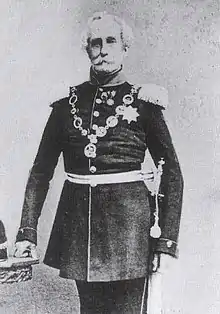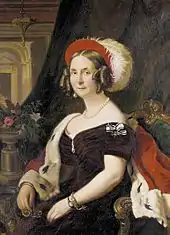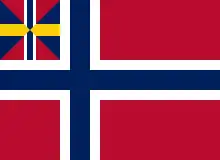Leopold IV, Duke of Anhalt
Leopold IV Frederick, Duke of Anhalt (1 October 1794 – 22 May 1871) was a German prince of the House of Ascania.
| Leopold IV | |||||
|---|---|---|---|---|---|
| Duke of Anhalt | |||||
 | |||||
| Reign | 9 August 1817 – 22 May 1871 | ||||
| Born | 1 October 1794 Dessau, Anhalt | ||||
| Died | 22 May 1871 (aged 76) Dessau, Anhalt | ||||
| Spouse | Princess Frederica of Prussia | ||||
| Issue among others... | Princess Auguste of Anhalt-Dessau Agnes, Duchess of Saxe-Altenburg Frederick I, Duke of Anhalt Maria Anna, Princess of Prussia | ||||
| |||||
| House | Ascania | ||||
| Father | Frederick, Hereditary Prince of Anhalt-Dessau | ||||
| Mother | Landgravine Amalie of Hesse-Homburg | ||||
From 1817 until 1853 he was ruler of the duchy of Anhalt-Dessau and from 1847 until 1853 also ruler of the duchy of Anhalt-Köthen. From 1853 until 1863 he was the ruler of the joined duchy of Anhalt-Dessau-Köthen and from 1863 the first ruler of the united duchy of Anhalt.
Early life
Leopold was born in Dessau on 1 October 1794 as the eldest son of Frederick, Hereditary Prince of Anhalt-Dessau, by his wife Landgravine Amalie of Hesse-Homburg, daughter of Frederick V, Landgrave of Hesse-Homburg.
Following the premature death of his father in 1814, he became heir to the duchy of Anhalt-Dessau.[1]
Reign
Following the death of his grandfather Leopold III he succeeded as duke on 9 August 1817.[1]
During the Revolutions of 1848 he was forced to grant a constitution to Dessau on 29 October 1848. It was revoked, however, on 4 November 1849, then replaced with a new version in October 1859. Leopold maintained a friendship with his administrative officer Wilhelm Christian Raster, though Raster's politically active son, Hermann participated in the revolutions.[2] The younger Raster was given the unusual choice to either stay in Anhalt-Dessau and face criminal prosecution for his role in the Revolution or to emigrate from the country freely like other Forty-Eighters. Raster made the second choice and eventually became a powerful Republican Party political boss in the United States.[3]
On 27 November 1847 he inherited the Duchy of Anhalt-Köthen from his distant cousin Duke Henry. As a result of a treaty concluded with Anhalt-Bernburg in May 1853 his duchies were joined together and named Anhalt-Dessau-Köthen, because the eventual inheritance of Leopold over all the Anhalt duchies seemed inevitable.[1] The death of another distant cousin, Duke Alexander Karl, on 19 August 1863 resulted in the ruling line of the duchy of Anhalt-Bernburg becoming extinct, thus Leopold inherited that duchy as well.[1] On 30 August he assumed the title "duke of Anhalt."[1]
Leopold died in Dessau on 22 May 1871. He was succeeded by his son Frederick.[4]
Marriage and issue

In Berlin on 18 April 1818 Leopold married Princess Frederica of Prussia (b. Berlin, 30 September 1796 - d. Dessau, 1 January 1850), daughter of Prince Frederick Louis Charles of Prussia (brother of King Frederick William III of Prussia) by his wife Frederica of Mecklenburg-Strelitz; through her mother's last marriage, she was a half-sister of King George V of Hanover.[1] They had been engaged since 17 May 1816, as the connection had already been arranged by the Prussian court. This dynastic connection was an expression of Leopold's pro-Prussian policies.
| Name | Birth | Death | Notes |
|---|---|---|---|
| Princess Fredericka Amalie Auguste | 28 November 1819 | 11 December 1822 | |
| Princess Fredericka Amalie Agnes | 24 June 1824 | 23 October 1897 | married on 28 April 1853 to Ernst I, Duke of Saxe-Altenburg. |
| A son | 3 August 1825 | 3 August 1825 | he was either stillborn or died shortly after the birth. |
| A son | 3 November 1827 | 3 November 1827 | he was either stillborn or died shortly after the birth. |
| Frederick I, Duke of Anhalt | 29 April 1831 | 24 January 1904 | married on 22 April 1854 to Princess Antoinette of Saxe-Altenburg. |
| Princess Maria Anna | 14 September 1837 | 12 May 1906 | married on 29 November 1854 to Prince Frederick Charles of Prussia. |
Honours
He received the following orders and decorations:[7]
 Austrian Empire:
Austrian Empire:
- Army Cross (1813/14)
- Grand Cross of the Royal Hungarian Order of St. Stephen, 1832[8]
.svg.png.webp) Baden: Grand Cross of the House Order of Fidelity, 1814[9]
Baden: Grand Cross of the House Order of Fidelity, 1814[9].svg.png.webp) Kingdom of Prussia:
Kingdom of Prussia:
- Knight of the Black Eagle, 30 March 1817[10]
- Knight of the Red Eagle, 1st Class
 Russian Empire:
Russian Empire:
- Knight of St. Andrew, 17 November 1834[11]
- Knight of St. Alexander Nevsky
- Knight of St. Anna, 1st Class
 Kingdom of Poland: Knight of the White Eagle
Kingdom of Poland: Knight of the White Eagle Ascanian duchies: Joint Founder and Grand Master of the Order of Albert the Bear, 18 November 1836[12]
Ascanian duchies: Joint Founder and Grand Master of the Order of Albert the Bear, 18 November 1836[12] Kingdom of Hanover:
Kingdom of Hanover:
- Grand Cross of the Royal Guelphic Order, 1839[13]
- Knight of St. George, 1840[13]
- Grand Cross of the Order of Ernst August
 Denmark: Knight of the Elephant, 25 December 1840[14]
Denmark: Knight of the Elephant, 25 December 1840[14].svg.png.webp)
.svg.png.webp)
.svg.png.webp) Ernestine duchies: Grand Cross of the Saxe-Ernestine House Order, March 1843[15]
Ernestine duchies: Grand Cross of the Saxe-Ernestine House Order, March 1843[15] Oldenburg: Grand Cross of the Order of Duke Peter Friedrich Ludwig, with Golden Crown, 18 April 1854[16]
Oldenburg: Grand Cross of the Order of Duke Peter Friedrich Ludwig, with Golden Crown, 18 April 1854[16].svg.png.webp) Kingdom of Bavaria: Knight of St. Hubert, 1854[17]
Kingdom of Bavaria: Knight of St. Hubert, 1854[17].svg.png.webp) Nassau: Knight of the Gold Lion of Nassau, May 1862[18]
Nassau: Knight of the Gold Lion of Nassau, May 1862[18].svg.png.webp)
 Sweden-Norway: Knight of the Seraphim, 14 May 1864[19]
Sweden-Norway: Knight of the Seraphim, 14 May 1864[19].svg.png.webp) Kingdom of Saxony: Knight of the Rue Crown, 1867[20]
Kingdom of Saxony: Knight of the Rue Crown, 1867[20]
Ancestry
References
- Almanach de Gotha. 1867. p. 3.
- Hermann Raster (1891). Reisebriefe von Hermann Raster: Mit einer Biographie und einem Bildniss des Verfassers. Buchdr. Gutenberg (F. Zillessen). pp. 8–9.
- "Inventory of the Hermann Raster Papers". The Newberry Library.
- "Duke of Anhalt is dead". The New York Times. 25 January 1904. p. 7.
- Genealogical database by Herbert Stoyan
- Marek, Miroslav. "Complete Genealogy of the House of Ascania". Genealogy.EU.
- Hof- und Staats-Handbuch des Herzogtum Anhalt (1867) "Das Herzoglicher Haus: Genealogie" p. 1
- "A Szent István Rend tagjai" Archived 22 December 2010 at the Wayback Machine
- Hof- und Staats-Handbuch des Großherzogtum Baden (1834), "Großherzogliche Orden" p. 31
- Liste der Ritter des Königlich Preußischen Hohen Ordens vom Schwarzen Adler (1851), "Von Seiner Majestät dem Könige Friedrich Wilhelm III. ernannte Ritter" p. 18
- "Андреевский кавалер – Герцог Леопольд IV Фридрих Франц фон Ангальт-Дессау-Кетен Александр Рожинцев" (in Russian). Archived from the original on 30 November 2011. Retrieved 6 August 2020.
- Hof- und Staats-Handbuch des Herzogtum Anhalt (1867) "Herzoglicher Haus-orden Albrecht des Bären" p. 13
- Staat Hannover (1865). Hof- und Staatshandbuch für das Königreich Hannover: 1865. Berenberg. pp. 37, 75.
- Jørgen Pedersen (2009). Riddere af Elefantordenen, 1559–2009 (in Danish). Syddansk Universitetsforlag. p. 463. ISBN 978-87-7674-434-2.
- Adreß-Handbuch des Herzogthums Sachsen-Coburg und Gotha (1847), "Herzogliche Sachsen-Ernestinischer Hausorden" p. 26
- Staat Oldenburg (1870). Hof- und Staatshandbuch des Großherzogtums Oldenburg: für ... 1869/70. Schulze. p. 28.
- Bayern (1870). Hof- und Staatshandbuch des Königreichs Bayern: 1870. Landesamt. p. 8.
- Staats- und Adreß-Handbuch des Herzogthums Nassau (1866), "Herzogliche Orden" p. 9
- Sveriges och Norges Statskalender (in Swedish), 1865, p. 428, retrieved 20 February 2019 – via runeberg.org
- Sachsen (1870). Staatshandbuch für den Freistaat Sachsen: 1870. Heinrich. p. 4.